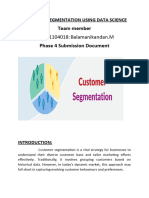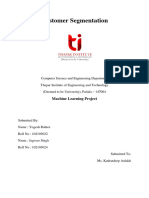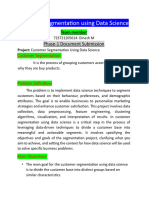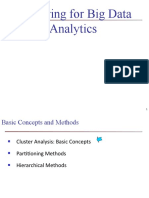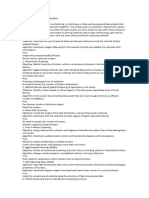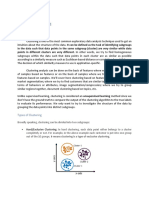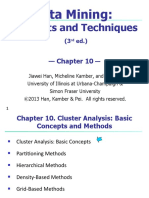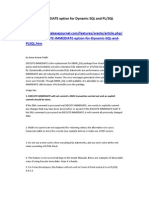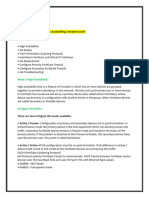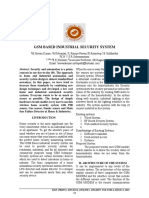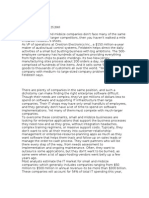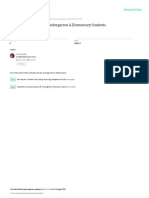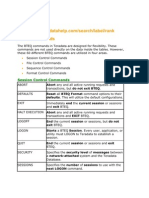Objectives of Clustering
1. Getting Data
Objective: Gather the raw data needed for analysis.
Data Sources:
o Internal Sources: Databases, transaction logs, customer records.
o External Sources: APIs, web scraping, third-party datasets.
o Generated Data: Surveys, experiments.
Data Types:
o Structured Data: Tabular data, such as CSV files or databases.
o Unstructured Data: Text, images, audio.
o Semi-structured Data: JSON, XML.
Example: If you're clustering customers, you might gather data on purchase
history, website behavior, and demographic information from your company's
CRM system.
2. Cleaning Data
Objective: Ensure the data is free from errors and inconsistencies.
Common Issues:
o Missing Data: Handle missing values by filling them with
mean/median values, using algorithms like K-Nearest Neighbors
(KNN), or simply removing the affected rows/columns.
o Duplicate Data: Remove duplicate entries to avoid skewing the
clustering results.
o Outliers: Detect and handle outliers that could distort cluster
formation, either by removing them or treating them separately.
Data Cleaning Techniques:
o Imputation: Filling missing data with appropriate values.
o Normalization: Adjusting data to ensure consistency, such as
converting all dates to a single format.
o Filtering: Removing unnecessary columns or rows.
Example: You might find missing age data in customer profiles. This could be filled
with the median age of the customers or treated as a separate cluster.
�3. Data Preprocessing
Objective: Prepare the data for the clustering algorithm by transforming it into a
suitable format.
Normalization and Scaling:
o Normalization: Adjust values to a common scale without distorting
differences in the ranges of values.
o Standardization: Scale data to have a mean of 0 and a standard
deviation of 1, useful for algorithms like K-Means.
Dimensionality Reduction:
o Techniques like Principal Component Analysis (PCA) reduce the
number of variables while retaining the most important information.
Feature Engineering:
o Creating new features from existing data to enhance the clustering
process.
o Encoding Categorical Variables: Convert categories into numerical
values using methods like one-hot encoding.
Example: If your customer data includes income, it may vary widely. Normalizing
the income data ensures that customers with high incomes don't
disproportionately influence the clustering.
4. Data Visualization
Objective: Visualize the data to understand its structure and the results of the
clustering.
Exploratory Visualization:
o Histograms and Box Plots: Used to understand the distribution of
individual features.
o Scatter Plots: Visualize relationships between two variables, helping
to identify potential clusters before applying any algorithm.
Visualizing Clusters:
o 2D/3D Scatter Plots: After clustering, plot the clusters to visualize
how the data points have been grouped.
o Cluster Centroids: In K-Means, visualize the centroids to understand
the center of each cluster.
� o Heatmaps: Show the correlation between features, which can help in
understanding the structure of the clusters.
Example: After clustering customers based on their purchasing behavior, you
could use a 2D scatter plot to visualize the clusters, where each point represents a
customer, and colors distinguish different clusters.
5. Clustering Process
Objective: Apply a clustering algorithm to group the data into meaningful
clusters.
Choosing the Right Algorithm:
o K-Means: Simple and widely used for partitioning data into K
clusters.
o Hierarchical Clustering: Builds a tree of clusters, useful when the
number of clusters is not known beforehand.
o DBSCAN: Useful for finding arbitrarily shaped clusters and handling
noise/outliers.
Running the Algorithm:
o Initialize the clustering process by choosing the appropriate
parameters (e.g., number of clusters for K-Means).
o Fit the model to the data, allowing it to group similar data points
together.
Evaluating the Clusters:
o Silhouette Score: Measures how similar a data point is to its own
cluster compared to other clusters.
o Elbow Method: Used in K-Means to determine the optimal number
of clusters by plotting the sum of squared distances and looking for
an "elbow" point.
Example: Using K-Means to group customers into 3 clusters based on their
shopping habits, you could evaluate the clustering quality with a silhouette score.
